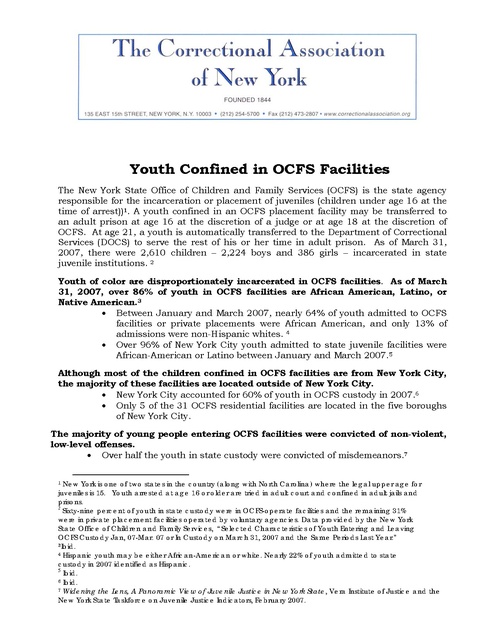Correctional Association of Ny Youth in Ocfs Nov 2007
Download original document:

Document text

Document text
This text is machine-read, and may contain errors. Check the original document to verify accuracy.
Youth Confined in OCFS Facilities The New York State Office of Children and Family Services (OCFS) is the state agency responsible for the incarceration or placement of juveniles (children under age 16 at the time of arrest))1. A youth confined in an OCFS placement facility may be transferred to an adult prison at age 16 at the discretion of a judge or at age 18 at the discretion of OCFS. At age 21, a youth is automatically transferred to the Department of Correctional Services (DOCS) to serve the rest of his or her time in adult prison. As of March 31, 2007, there were 2,610 children – 2,224 boys and 386 girls – incarcerated in state juvenile institutions. 2 Youth of color are disproportionately incarcerated in OCFS facilities. As of March 31, 2007, over 86% of youth in OCFS facilities are African American, Latino, or Native American.3 • Between January and March 2007, nearly 64% of youth admitted to OCFS facilities or private placements were African American, and only 13% of admissions were non-Hispanic whites. 4 • Over 96% of New York City youth admitted to state juvenile facilities were African-American or Latino between January and March 2007.5 Although most of the children confined in OCFS facilities are from New York City, the majority of these facilities are located outside of New York City. • New York City accounted for 60% of youth in OCFS custody in 2007.6 • Only 5 of the 31 OCFS residential facilities are located in the five boroughs of New York City. The majority of young people entering OCFS facilities were convicted of non-violent, low-level offenses. • Over half the youth in state custody were convicted of misdemeanors.7 1 New York is one of two states in the country (along with North Carolina) where the legal upper age for juveniles is 15. Youth arrested at age 16 or older are tried in adult court and confined in adult jails and prisons. 2 Sixty-nine percent of youth in state custody were in OCFS-operate facilities and the remaining 31% were in private placement facilities operated by voluntary agencies. Data provided by the New York State Office of Children and Family Services, “Selected Characteristics of Youth Entering and Leaving OCFS Custody Jan, 07-Mar. 07 or In Custody on March 31, 2007 and the Same Periods Last Year.” 3Ibid. 4 Hispanic youth may be either African-American or white. Nearly 22% of youth admitted to state custody in 2007 identified as Hispanic. 5 Ibid. 6 Ibid. 7 Widening the Lens, A Panoramic View of Juvenile Justice in New York State, Vera Institute of Justice and the New York State Taskforce on Juvenile Justice Indicators, February 2007. Incarcerating youth in OCFS facilities is extremely expensive. • New York State spends over $150 million a year to incarcerate youth in juvenile institutions.8 • In 2006, it cost over $127,000 a year to incarcerate child in a secure OCFS facility.9 Youth confined in OCFS facilities have special needs that the state does not adequately address. • Nearly 78% of the OCFS population was identified as needing treatment for substance abuse in 2007.10 • In 2007, nearly 24% percent of youth confined in OCFS facilities were identified as in need of special education. 11 • Over 55% of youth in OCFS facilities were screened as needing mental health services.12 • A 2001 audit by the New York State Comptroller found that children placed in OCFS facilities did not get mandated drug treatment, counseling and aftercare services.13 Incarcerating youth in OCFS facilities is not an effective approach to reducing youth crime and recidivism. The vast majority of boys and a significant proportion of girls are rearrested after release from OCFS. • A 1999 OCFS recidivism study found that 81% of boys and 45% of girls released from OCFS custody were rearrested within 36 months. Of these girls and boys combined, 75% were arrested for a felony or misdemeanor, and 62% had at least one arrest leading to a conviction.14 In contrast to OCFS confinement, alternatives to incarceration are much more effective in treating children’s needs and preventing future crime. Alternatives to incarceration also cost much less that placement in OCFS. • Community-based alternative-to-incarceration programs for youth in New York City, such as the DOME Project, BronxConnect, the Center for Community Alternatives, and CASES have recidivism rates lower than 20%. • A 2006 study by the NYC Independent Budget Office found that the Esperanza program and the Enhanced Supervision Program (ESP), two alternative-toplacement programs for youth adjudicated as juvenile delinquents, will save New York City nearly $5 million in reduced incarceration costs by the end of 2006. The ESP program costs less than $5,000 a year per youth and the Esperanza program costs less than $15,000 a year per youth. 15 New York State Executive Budget Documents, 2007-08. www.state.ny.us. This figure is based on per diem rate of nearly $348 for secure facilities. New York State Office of Children and Family Services (OCFS), Administrative Directive 06-OCFS-ADM-06, November 17, 2006. 10 Data provided by the New York State Office of Children and Family Services, “Selected Characteristics of Youth Entering and Leaving OCFS Custody Jan, 07-Mar. 07 or In Custody on March 31, 2007 and the Same Periods Last Year.” 11 Ibid. 12 Ibid. 13 State of New York Office of the Comptroller, Division of Management Audit and State Financial Services, “Office of Children and Family Services: Identifying and Treating Youth Needs.” January 2001, p. 20. 14 Factors Contributing to Recidivism Among Youth Placed with the New York State Division for Youth, New York State Division of Criminal Justice Services, 1999. 17 New York City Independent Budget Office, “News Fax: Alternative to Jail Programs for Juveniles Reduce City Costs,” July 11, 2006. (www.ibo.nyc.ny.us) 8 9 (November 2007)





